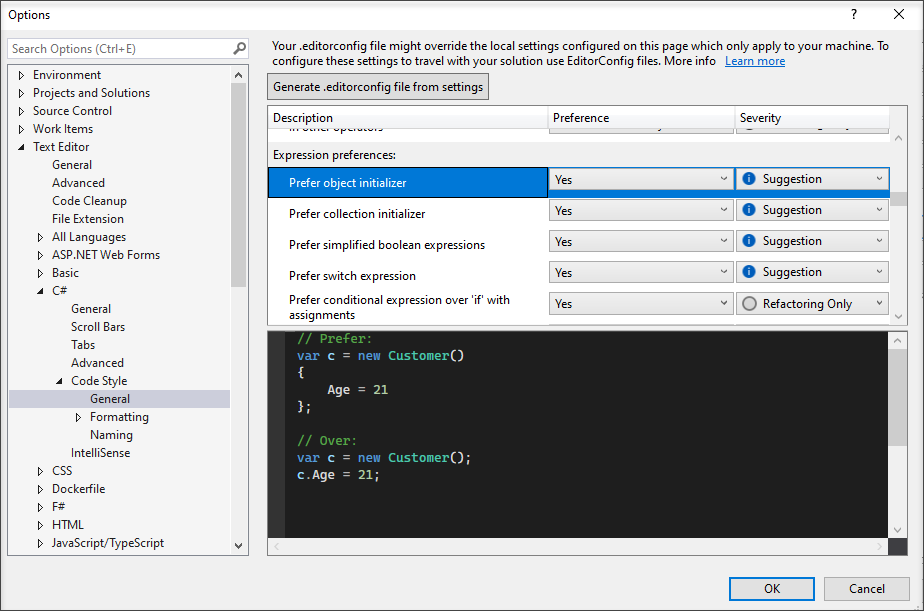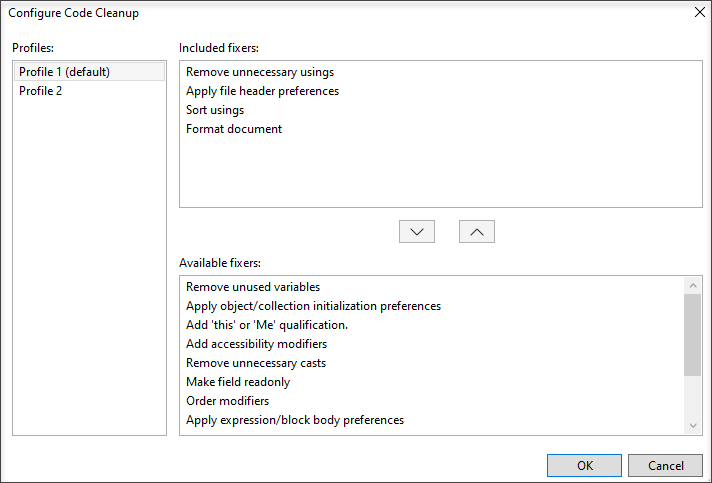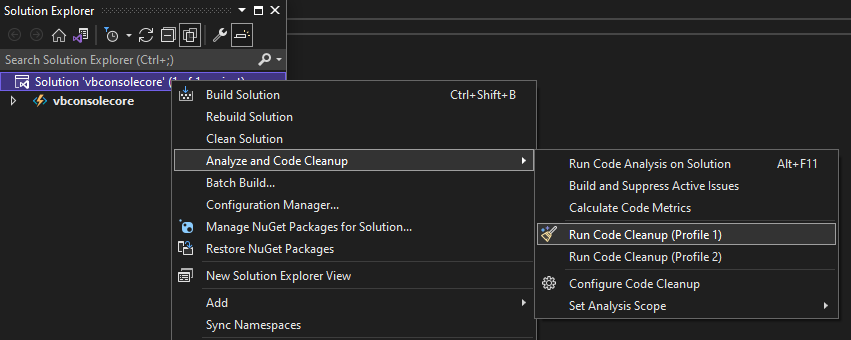Note
Access to this page requires authorization. You can try signing in or changing directories.
Access to this page requires authorization. You can try changing directories.
Code style preferences allow you to control aspects of code such as indent style, tab width, end-of-line characters, encoding, and many other formatting choices. You can define code style settings in two ways:
- Per-codebase or per-project by using an EditorConfig file, or
- For all code you edit in Visual Studio based on settings for the text editor .NET Options page or C/C++ Options page.
You can also configure Visual Studio to apply code style preferences using the Code Cleanup and Format Document commands.
For .NET, the code style preferences are based on .NET compiler platform (Roslyn) analyzers. For more information, see Code analysis using .NET compiler platform (Roslyn) analyzers.
In Visual Studio 2019 version 16.5 and later, rule set files are deprecated in favor of EditorConfig files for code style configuration for .NET code. For more information, see Convert an existing rule set file to an EditorConfig file.
Code styles in EditorConfig files
Code style settings can be specified by adding an EditorConfig file to your project. EditorConfig files are associated with a codebase rather than a Visual Studio personalization account. Settings in an EditorConfig file take precedence over code styles that are specified in the Options dialog box. Use an EditorConfig file when you want to enforce coding styles for all contributors to your repo or project. They are especially useful to ensure consistency in a teams programming environment.
To add an EditorConfig file, see Add and remove EditorConfig files.
For reference information on .NET code style settings, see Code style settings.
C/C++ code styles in the Options dialog box
You can specify many individual code formatting options, such as indentation and brace positions. To do so, go to Tools > Options > Text Editor > C/C++ > Code Style > Formatting (or type Ctrl + Q and search for "Formatting"). Alternatively, you can specify one of the ClangFormat styles (or your own custom ClangFormat style).

For more information about all the formatting options, see Options, Text Editor, C/C++, Formatting.
.NET code styles in the Options dialog box
Code style preferences can be set for all of your C# and Visual Basic projects by opening the Options dialog box from the Tools menu. In the Options dialog box, select Text Editor > [C# or Visual Basic] > Code Style.
- For formatting styles, select options under Formatting.
- For code style preferences associated with Quick Actions and IDE code style rules, select options under General or Naming.
Each item in the list shows a preview of the preference when you select the option:

Options set in this window are applicable to your Visual Studio personalization account and aren't associated with a particular project or codebase. In addition, they aren't enforced at build time, including in continuous integration (CI) builds. If you want to associate code style preferences with your project and have the styles enforced during build, specify the preferences in an EditorConfig file that's associated with the project.
Preference and severity
For each code style setting on the General and Naming options pages, you can set the Preference and Severity values using the drop-downs on each line. Severity can be set to Refactoring Only, Suggestion, Warning, or Error.
- Code style preferences in the General and Naming options pages determine the Quick Actions for a code style. The Quick Actions light bulb
 , error light bulb
, error light bulb  , or screwdriver
, or screwdriver  icon appears when a non-preferred style is used, and you can choose an option on the Quick Actions list to automatically rewrite code to the preferred style.
icon appears when a non-preferred style is used, and you can choose an option on the Quick Actions list to automatically rewrite code to the preferred style. - If you want the violation to appear only as a Quick Action and also be excluded from code cleanup, set the Severity to Refactoring Only.
- If you want the violation to appear in the Error List window as well as Quick Actions, and be included in code cleanup, set the Severity to Suggestion, Warning, or Error. Violations appear as a suggestion (message), warning, or error when you set the output in the Error List window to Build + IntelliSense. They are excluded from Build only output.
Settings in an EditorConfig file take precedence over code styles set in these pages.
Enforce code styles on build
Starting in Visual Studio 2019 version 16.8, which includes the .NET 5.0 RC2 SDK, you can enforce the .NET coding conventions on build for all .NET projects. At build time, .NET code style violations will appear as warnings or errors with an "IDE" prefix. This enables you to strictly enforce consistent code styles in your codebase.
Apply code styles
When you change a code style in the Options page or add an EditorConfig file to your project in Visual Studio, only new lines of code are formatted based on the new settings. The formatting of existing code isn't changed unless you run one of the following commands:
-
Select Code Cleanup in the Visual Studio editor, or press Ctrl+K, Ctrl+E. This command applies to white-space settings, such as indent style, and selected code-style settings, such as parenthesis preferences.
Format Document.
Select Edit > Advanced > Format Document, or press Ctrl+K, Ctrl+D in the default profile. This command applies only to white-space settings, such as indent style.
Apply code styles using code cleanup
To apply code styles from an EditorConfig file or from the Code Style options page, use the Code Cleanup button at the bottom of the editor (keyboard: Ctrl+K, Ctrl+E). If an EditorConfig file exists for the project, those are the settings that take precedence.
Tip
.NET rules configured with a severity of Refactoring Only don't participate in code cleanup but can be individually applied via the Quick Actions and Refactorings menu.
To apply code styles:
First, configure which code styles you want to apply (in one of two profiles) in the Configure Code Cleanup dialog box. To open this dialog box, click the expander arrow next to the code cleanup broom icon and then choose Configure Code Cleanup. Alternatively, use the Analyze > Code Cleanup menu.

For a mapping of .NET code cleanup fixers to .NET code style rules, see .NET code cleanup settings.
C/C++ options include C++ in the name of the fixer.
After you've configured code cleanup, use one of the following methods to run code cleanup:
Click on the broom icon or press Ctrl+K, Ctrl+E.

To run code cleanup across your entire project or solution, right-click the project or solution name in Solution Explorer, select Analyze and Code Cleanup, and then select Run Code Cleanup.

(Optional) If you want your code style settings to be applied every time you save a file, go to Options > Text Editor > Code Cleanup and select Run Code Cleanup profile on save.
.NET code cleanup settings
Most of the code cleanup settings map to one or more .NET code styles supported in EditorConfig. For examples that show the effects of the settings, use the links in the following table.
| Setting | Rule ID or style option |
|---|---|
| Remove unnecessary Imports or usings | IDE0005 |
| Sort imports or usings | dotnet_sort_system_directives_first dotnet_separate_import_directive_groups |
| Apply file header preferences | file_header_template |
| Remove unused variables | CS0219 |
| Apply object creation preferences | visual_basic_style_prefer_simplified_object_creation |
| Apply IsNot preferences | visual_basic_style_prefer_isnot_expression |
| Add 'this' or 'Me' qualification | IDE0003-IDE0009 |
| Add accessibility modifiers | dotnet_style_require_accessibility_modifiers |
| Order modifiers | IDE0036 |
| Make field readonly | dotnet_style_readonly_field |
| Remove unnecessary casts | IDE0004 |
| Apply object/collection initialization parameters) | dotnet_style_object_initializer |
| Apply using directive placement preferences | csharp_using_directive_placement |
| Apply parentheses preferences | IDE0047-IDE0048 |
| Apply unused value preferences | IDE0058 |
| Apply language/framework type preferences | IDE0049 |
| Remove unused suppressions | dotnet_remove_unnecessary_suppression_exclusions |
| Apply simplify boolean expression preferences | dotnet_style_prefer_simplified_boolean_expressions |
| Apply string interpolation preferences | dotnet_style_prefer_simplified_interpolation |
| Remove unused parameters | dotnet_code_quality_unused_parameters |
| Apply auto property preferences | dotnet_style_prefer_auto_properties |
| Apply compound assignment preferences | dotnet_style_prefer_compound_assignment |
| Apply coalesce expression preferences | dotnet_style_coalesce_expression |
| Apply conditional expression preferences | dotnet_style_prefer_conditional_expression_over_assignment dotnet_style_prefer_conditional_expression_over_return |
| Apply tuple name preferences | dotnet_style_explicit_tuple_names dotnet_style_prefer_inferred_tuple_names |
| Apply inferred anonymous type member names preferences | dotnet_style_prefer_inferred_anonymous_type_member_names |
| Apply null checking preferences | dotnet_style_prefer_is_null_check_over_reference_equality_method |
| Apply null propagation preferences | dotnet_style_null_propagation |
| Apply 'var' preferences | IDE0007-IDE0008 |
| Add required braces for single-line control statements | csharp_prefer_braces |
| Apply expression/block body preferences | Expression-bodied members |
| Apply inline 'out' variables preferences | csharp_style_inlined_variable_declaration |
| Apply pattern matching preferences | Pattern-matching preferences |
| Apply conditional delegate call preferences | csharp_style_conditional_delegate_call |
| Apply static local function preferences | csharp_prefer_static_local_function |
| Apply deconstruct preferences | csharp_style_deconstructed_variable_declaration |
| Apply default(T) preferences | csharp_prefer_simple_default_expression |
| Apply new() preferences | csharp_style_implicit_object_creation_when_type_is_apparent |
| Apply range preferences | csharp_style_prefer_range_operator |
| Apply local over anonymous function preferences | csharp_style_pattern_local_over_anonymous_function |
| Apply parameter null preferences | Null-checking preferences |
| Apply using statement preferences | csharp_prefer_simple_using_statement |
| Apply throw expression preferences | csharp_style_throw_expression |